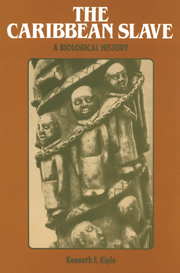Book contents
- Frontmatter
- Contents
- List of Tables
- Preface
- Acknowledgments
- Part I Background and Biology
- Introduction
- 1 The Peoples and Their Pathogens
- 2 West African Diet and Disease
- 3 The Parameters of West African Survival
- Part II Diet, Disease, and Demography
- Part III Pathogens and Politics
- Notes
- Bibliographic Essay
- Index
2 - West African Diet and Disease
Published online by Cambridge University Press: 19 October 2009
- Frontmatter
- Contents
- List of Tables
- Preface
- Acknowledgments
- Part I Background and Biology
- Introduction
- 1 The Peoples and Their Pathogens
- 2 West African Diet and Disease
- 3 The Parameters of West African Survival
- Part II Diet, Disease, and Demography
- Part III Pathogens and Politics
- Notes
- Bibliographic Essay
- Index
Summary
And [man] has favored disease-selection by developing dietaries that are themselves growth limiting, and inimical to the maintenance of an optimum immunochemical [defense] system.
S.M. Garn (1963)In Africa malnutrition lurks like an evil spirit in the homes of the majority and exerts its most devastating effect on the very young.
R.G. Hendrickse (1966)It has been observed that “if we compare the heights and weights of African children with those of their age mates in Europe and America, we find that the vast majority of African children are well below the expected norm for their ages.” This observer we have just quoted, as others, had no difficulty in explaining the variance in heights, for studies have made it clear that the reason a people fail to achieve their genetic potential for height is generally a function of malnutrition, and sub-Saharan children are, as a rule, considerably less well nourished than European or North American counterparts.
Thanks to a number of recent examinations of slave height data, we can discern similar evidence of West African malnutrition for the early nineteenth century. These ongoing studies have revealed that slaves born in the West Indies (Creoles) were significantly taller (one to three inches) than counterparts born in Africa. Because the phenomenon of a rapid increase in the height of a people (such as second- and third-generation Japanese and Chinese in the United States) is linked tightly to nutrition, the conclusion seems inescapable that even the miserable diet of slaves in the Americas was superior to (or at least more protein laden than) that of their African cousins.
- Type
- Chapter
- Information
- The Caribbean SlaveA Biological History, pp. 23 - 37Publisher: Cambridge University PressPrint publication year: 1985



